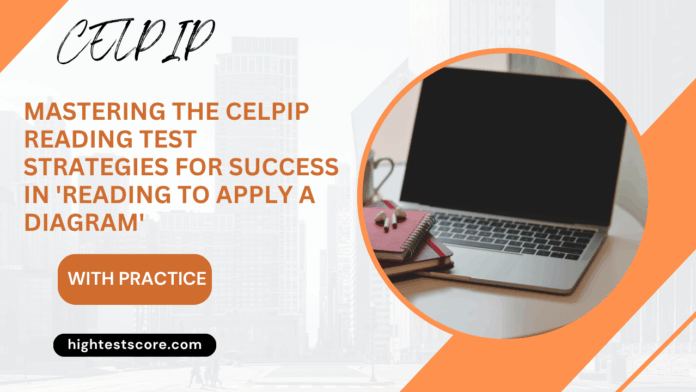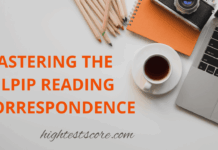Introduction
Navigating the “Reading to Apply a Diagram” Section of the CELPIP Reading Test can be a challenging but rewarding experience. This section is a test of your ability to interpret and use visual information in a practical context, a skill that is essential for many everyday tasks. With the right strategies and preparation, you can approach this part of the CELPIP Reading Test with confidence and improve your overall test performance. This article provides a detailed breakdown of the key elements of the “Reading to Apply a Diagram” section, offering valuable insights into its structure, effective reading strategies, common mistakes to avoid, and practical tips for success. Whether you are a first-time test taker or looking to enhance your skills, this comprehensive guide will equip you with the knowledge and tools you need to excel.
Overview of ‘Reading to Apply a Diagram’ Task
The ‘Reading to Apply a Diagram’ section is designed to assess your ability to read and use information presented in a visual format. In this part of the CELPIP Reading Test, you will be given a diagram, such as a chart, map, schedule, or a graphical representation, along with several questions or scenarios. Your task will be to interpret the information in the diagram and select the correct answers based on that information.
Here’s a breakdown of the key components and format of the ‘Reading to Apply a Diagram’ task:
Diagrams:
* Format: A single diagram is presented, which could be a bus schedule, a map, a chart, a floor plan, or a process flow diagram, among other possibilities.
* Content: The diagram will contain various pieces of information that are relevant to the questions or scenarios provided.
Questions/Scenarios:
* Structure: There will be four questions or scenarios related to the given diagram. Each question/scenario presents a specific situation or query.
* Purpose: Your job is to match the information in each question/scenario to the correct answer using the diagram.
Answers:
* Format: For each of the four questions/scenarios, there will be four possible answers.
* Selection: You must choose the most appropriate answer for each question/scenario by applying the information from the diagram.
Your responsibilities in this section include:
* Quickly locating the information in the diagram that is relevant to each question/scenario.
* Understanding and interpreting the relationships, patterns, or sequences that are visually represented in the diagram.
* Accurately applying the details from the diagram to answer the scenario-based questions.
There are 8 questions in total in this section. Each question will ask you to determine the best option, make a decision, or provide an answer based on the information in the diagram and the details in the question/scenario. Time management and a systematic approach are crucial for successfully completing this part of the CELPIP Reading Test.
Analyzing Diagram Components
As you can see from the example above, the most important aspect of the ‘Reading to Apply a Diagram’ task is a diagram. There are many different types of diagrams that might be presented in the CELPIP Reading Test, including schedules and timetables, maps and floor plans, charts and tables, and process flows or diagrams. Diagrams present information in a visual way that often shows relationships, movements, or sequences.
In order to understand a diagram, you first need to be able to recognize its main components and how they work together. In this section, we will break down the essential steps and skills that you will need to learn in order to analyze diagram components successfully.
1. Identifying the Diagram Type
The first step to understanding any diagram is to recognize what type of diagram it is. The main diagram types that you might encounter on the CELPIP Reading Test are:
* Schedules and Timetables: These show times, dates, or sequences for events, services, or activities.
* Maps and Floor Plans: These provide spatial relationships, locations, or directions.
* Charts and Tables: These organize data into rows and columns for comparison.
* Process Flows and Diagrams: These illustrate steps in a process or the relationships between different stages.
Knowing the type of diagram you are looking at will help you to anticipate what kind of information you are looking for and how to find it efficiently.
2. Examining Headings and Labels
All diagrams have titles, headings, subheadings, labels, or keys. These textual elements provide context and explain what the diagram is about. They also guide your interpretation of the visual data. Key elements to look for include:
* Titles: Give an overall idea of the diagram’s content or purpose.
* Labels: Indicate what each part of the diagram represents, such as days of the week, bus stops, rooms, or categories.
* Keys/Legends: Explain symbols, colors, or abbreviations used in the diagram.
Make sure to read these carefully, as they are often key to understanding the rest of the diagram.
3. Interpreting Visual Cues and Symbols
Diagrams use visual cues like arrows, lines, colors, or shading to represent information non-verbally. For example:
* Arrows might show direction or order of steps in a process.
* Colors could differentiate between groups or time periods.
* Lines or paths may indicate routes or connections between locations.
Pay attention to these visual elements, as they provide important information that you will need to answer the questions.
4. Locating and Comparing Key Details
Once you have a general understanding of the diagram, you will need to find specific details that are relevant to the questions or scenarios. This might involve:
* Identifying exact times, dates, or locations.
* Finding steps or stages in a process.
* Comparing differences and similarities between categories or options.
It can be helpful to cross-reference the question/scenario with the diagram, highlighting or jotting down the relevant section to avoid confusion.
5. Understanding Relationships and Patterns
Many questions based on diagrams will require you to understand the relationship between different pieces of information, such as cause and effect, sequence, or spatial arrangement. For example, you might need to determine:
* Which event precedes another?
* What is the shortest path between two points?
* How does a change in one part of the diagram affect another?
Practicing how to quickly identify these relationships is key to finding the correct answers.
6. Avoiding Assumptions by Relying on Visual Evidence
It is important not to let background knowledge or assumptions influence your answers. If something is not shown or labeled in the diagram, it should not be included in your answer. Always base your responses on the information that is provided visually.
7. Practicing with Different Diagram Types
Familiarity with different types of diagrams comes with practice. The more you practice analyzing the components of various diagrams, the more quickly and accurately you will be able to extract the necessary information. Use sample questions, practice tests, and real-life examples like transit maps, event schedules, or building layouts to practice.
Effective Reading Strategies
Approaching the “Reading to Apply a Diagram” section of the CELPIP Reading Test with the right strategies can make a significant difference in your performance. By understanding how to efficiently read and interpret the questions and scenarios in relation to the diagrams, you can increase your accuracy and confidence. This section will provide you with key reading strategies that will help you approach each diagram in the most effective way, ensuring you minimize mistakes and maximize your test performance.
1. Preview the Diagram and Questions First
Before you start looking at the answer choices, take a moment to carefully examine the diagram and quickly read through all the related questions. This initial preview helps you to get an overview of what information you need to locate and prevent unnecessary rereading later on. It sets the stage for efficient information processing.
2. Scan for Keywords
Identify important keywords or phrases in the questions or scenarios—such as names, dates, locations, or specific actions. Once you’ve identified these, scan the diagram for the same keywords or related information. This targeted scanning approach will save you time and improve your accuracy in finding the relevant details.
3. Use the Process of Elimination
For multiple-choice questions, one of the most effective strategies is to eliminate obviously incorrect options first. By narrowing down your choices, you increase your chances of selecting the correct answer, even if you’re not 100% sure. Trust your instincts when you have a reasonable degree of certainty.
4. Refer Back to the Diagram Frequently
It’s easy to start relying on memory after scanning the diagram, but always double-check your answers by referring back to the diagram. Ensure that the information you select directly corresponds with what is visually presented, rather than what you think should be the answer.
5. Pay Attention to Details
Diagrams often include small but critical details such as symbols, color codes, or time increments that can be the key to the correct answer. Carefully read all legends, headings, and labels to ensure you do not overlook any information.
6. Manage Your Time Wisely
Allocate a specific amount of time for each question. If you find yourself spending too long on one, make your best guess and move on to the next question to ensure you have time to attempt all items. If time permits, you can always return to more difficult questions later.
7. Stay Calm and Focused
If at any point you start to feel overwhelmed or panicked, take a deep breath and refocus on the task at hand. A calm and methodical approach will help you to interpret the information more accurately and efficiently.
By employing these reading strategies, you can approach the “Reading to Apply a Diagram” section with greater confidence, reduce errors, and enhance your overall test-taking performance.
Common Mistakes and How to Avoid Them
As with any part of the CELPIP Reading Test, it’s possible to make some common mistakes in the “Reading to Apply a Diagram” section. Being aware of these potential pitfalls and knowing how to avoid them can help you improve your accuracy and boost your confidence when you take the test. In this section, we will discuss the most common mistakes that test takers make in the “Reading to Apply a Diagram” section, and provide tips on how to avoid them.
1. Overlooking Diagram Details
One frequent mistake is failing to notice small but important details in the diagram, such as labels, legends, or color codes. These elements can contain crucial information for answering the questions correctly. To avoid this, always take a few seconds to review all parts of the diagram, including any keys or notes, before answering.
2. Making Assumptions
Some test takers answer questions based on prior knowledge or assumptions rather than relying solely on the information presented in the diagram. Remember, your answers must be supported by information that can be found directly in the diagram. If something is not shown or is not clearly stated, do not include it in your answer.
3. Misreading Questions or Scenarios
Rushing through the questions can lead to misunderstanding what is being asked. Carefully read each question and scenario to ensure you understand exactly what information to look for. If possible, underline or highlight keywords.
4. Ignoring Relationships and Patterns
Many diagrams require you to understand sequences, relationships, or connections, such as time order or routes. Neglecting to notice these patterns can lead to incorrect answers. Train yourself to look for and interpret arrows, lines, or other indicators of relationships.
5. Poor Time Management
Spending too much time on one question can mean running out of time for others. Set a time limit for each question and move on if you’re stuck. You can always come back to difficult questions if you have time at the end.
6. Not Double-Checking Answers
Some test takers select an answer based on memory rather than verifying it against the diagram. Always refer back to the visual before finalizing your answer to make sure it matches the details provided.
By being aware of these common mistakes and practicing strategies to avoid them, you can approach the “Reading to Apply a Diagram” section more effectively and increase your chances of achieving a high score.
Practice
Reading Part 2: Reading to Apply a Diagram
Subject: Team Building Retreat
To: All Staff
From: Human Resources
Hello everyone,
We are excited to announce our annual team building retreat! This year, we have three destination options: Lakeview Lodge, Mountain Pines Resort, and Riverbend Camp. Please review the summary below and let us know your preference by Friday.
| Destination | Accommodation Type | Activities Included | Distance from City | Cost per Person | Meals Provided |
| Lakeview Lodge | Hotel | Kayaking, hiking, yoga | 80 km | 220 $ | All meals |
| Mountain Pines | Cabins | Rock climbing, Ziplining | 120 km | 180 $ | Breakfast only |
| Riverbend Camp | Tents | Canoeing, team games, fishing | 60 km | 140 $ | Lunch only |
– Lakeview Lodge offers comfortable hotel rooms and a full meal plan, with activities like kayaking and yoga.
– Mountain Pines provides rustic cabins, adventure sports, and only breakfast included.
– Riverbend Camp is the most affordable, with tent accommodation and outdoor activities, but only lunch is provided.
Please consider your preferences for comfort, activities, and budget before choosing.
Best,
HR Team
—
Questions:
Choose the best option according to the information in the message and table.
- The least expensive destination is
– Lakeview Lodge.
– Mountain Pines Resort.
– Riverbend Camp.
– Lakeview Hotel.
- If you want all meals provided, you should choose
– Riverbend Camp.
– Mountain Pines Resort.
– Lakeview Lodge.
– None of the above.
- Which destination is farthest from the city?
– Lakeview Lodge
– Mountain Pines Resort
– Riverbend Camp
– Riverbend Lodge
- Someone interested in yoga should select
– Mountain Pines Resort.
– Lakeview Lodge.
– Riverbend Camp.
– None of the above.
- If you prefer cabins and adventure sports, you should choose
– Lakeview Lodge.
– Mountain Pines Resort.
– Riverbend Camp.
– Lakeview Hotel.
- The main purpose of this retreat is to
– train new employees.
– build teamwork among staff.
– offer a vacation to employees.
– celebrate a company anniversary.
- The HR team asks staff to
– pay for their own meals.
– vote for their preferred destination.
– organize their own transportation.
– bring their own tents.
- Which destination offers canoeing?
– Lakeview Lodge
– Mountain Pines Resort
– Riverbend Camp
– All of them
—
Answers:
- Riverbend Camp
- Lakeview Lodge
- Mountain Pines Resort
- Lakeview Lodge
- Mountain Pines Resort
- build teamwork among staff
- vote for their preferred destination
- Riverbend Camp
Conclusion and Future Directions
As you continue to prepare for the CELPIP Reading Test, keep practicing with a variety of practice diagrams and stay up to date with any changes or updates to the CELPIP test formats and content. Continuous practice and familiarization with different types of diagrams will further strengthen your skills and boost your confidence. With dedication and the right approach, you’ll be well-prepared to succeed on test day and in real-world situations that require the same skills.









